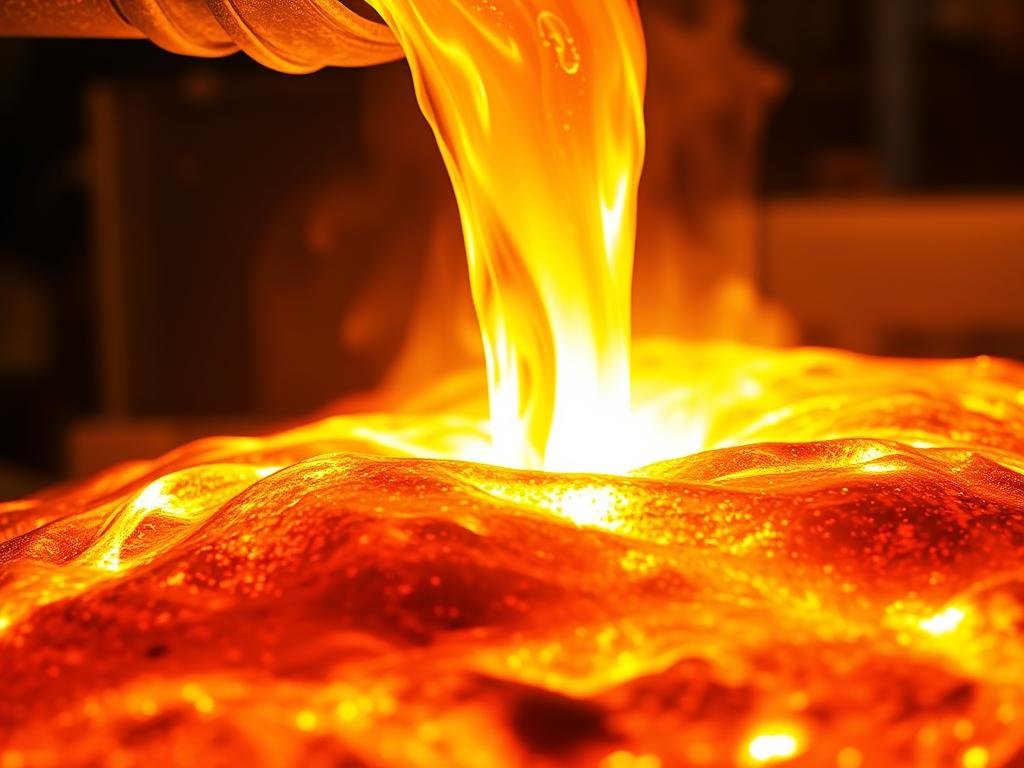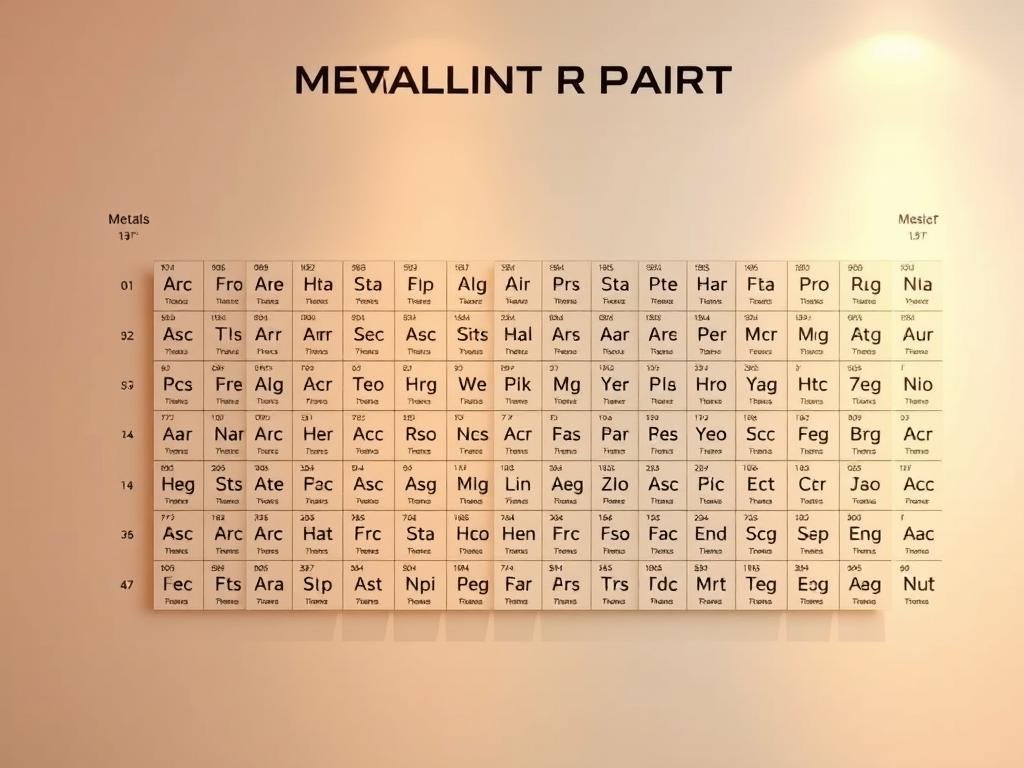The temperature at which a metal transitions from a solid to a liquid is crucial in various engineering applications. Understanding the comportement de fusion of metals is essential for selecting the right materials for specific temperature environments.
Ce guide complet explore les points de fusion de divers métaux, leur importance en ingénierie, et les principes scientifiques derrière les changements de phase des métaux. En examinant les propriétés thermiques des métaux, les ingénieurs peuvent prévenir la défaillance des composants et optimiser les processus de fabrication.
Les professionnels de la métallurgie, de la fabrication et de l'aérospatiale s'appuient sur ces connaissances pour prendre des décisions éclairées. Une fusion détaillée point chart of common metals categorized by temperature ranges will be provided, serving as a valuable resource for engineers and researchers alike.
Understanding Metal Melting Points
The concept of melting points is crucial in understanding the properties of metals. At its core, the melting point represents the temperature at which a metal transitions from a solid to a liquid state.
What Is a Melting Point?
The melting point is the temperature at which a metal begins to transform from a solid phase into a liquid phase. At this temperature, the solid and liquid phases of the metal coexist in equilibrium. As noted by a renowned metallurgist, “The melting point is a critical property that determines the usability of a metal in various applications.”
The Science Behind Metal Phase Changes
When a metal reaches its melting point, the atomic bonds begin to weaken and break, allowing the metal to change its state from solid to liquid. This process involves the concept of latent heat of fusion, which is the energy required to convert a solid metal to liquid without changing its temperature. Understanding this phase change is essential for optimizing manufacturing processes and preventing component failure in high-temperature environments.
As metals transition from solid to liquid, their crystalline structure plays a significant role in determining their melting behavior. Different metal lattices respond uniquely to heat, influencing their melting points.
Why Melting Points of Metals Matter in Engineering
Understanding the melting points of metals is crucial for various engineering applications. The melting point of a metal is a critical property that determines its suitability for different uses, especially in high-temperature environments.
Preventing Component Failure
One of the primary reasons melting points matter is to prevent component failure. When metals are exposed to temperatures near their melting points, they can lose their structural integrity, leading to potential failures. For instance, in aerospace engineering, components are often subjected to extreme temperatures, making the selection of metals with appropriate melting points vital.

Optimizing Manufacturing Processes
Knowledge of metal melting points is also essential for optimizing manufacturing processes such as casting, welding, and forging. For example, the equipment used for casting must have a higher melting point than the metal being cast to prevent it from deforming or failing during the process.
| Métal | Point de fusion (°C) | Applications courantes |
|---|---|---|
| Aluminium | 660.32 | Aerospace, Automotive |
| Cuivre | 1085 | Electrical Wiring, Plumbing |
| Tungsten | 3422 | High-Temperature Furnaces, Light Bulb Filaments |
As highlighted by a study on metal failures, “The selection of materials with appropriate melting points is critical for ensuring the reliability and safety of engineering components” (
This is a critical consideration in engineering design, where the margin between operating temperature and melting point can be a key factor in component longevity.
).
Factors Affecting Metal Melting Points
Understanding the factors that affect metal melting points is crucial in engineering. The melting behavior of metals is influenced by their atomic structure and bond strength.
Atomic Structure and Bond Strength
The atomic arrangement and electron configuration of a metal determine its melting point. Metals with more delocalized electrons and closely packed atoms have stronger bonds, requiring more energy to break and resulting in higher points de fusion.
Impurities and Alloying Elements
Impurities and alloying elements can significantly alter a metal’s melting behavior. These elements can either raise or lower the temperature at which a metal transitions from solid to liquid.
Pressure and Particle Size
External factors like pression and the size of metal particles also influence melting behavior. In specialized industrial applications, changes in pressure can modify melting points, while metal powders and nanoparticles often exhibit different melting properties than bulk materials.
Complete Melting Point Chart of Common Metals
The melting point chart of common metals serves as a valuable resource for various industrial applications. Metals are typically categorized into three groups based on their melting points: low, medium, and high.
Low Melting Point Metals
Low melting point metals have melting points below 500°C. These include gallium (29.8°C), mercury (-38.83°C), indium (156.6°C), tin (231.9°C), bismuth (271.3°C), lead (327.5°C), and selenium (217°C). These metals are often used in applications where low melting points are advantageous, such as in soldering and fusible alloys.
Medium Melting Point Metals
Medium melting point metals range from 500°C to 1500°C. Examples include aluminum (660°C), brass (930°C), copper (1084°C), gold (1063°C), silver (961°C), and cast iron (1204°C). These metals are commonly used in a wide range of applications, including construction, electrical wiring, and jewelry.
High Melting Point Metals
High melting point metals have melting points above 1500°C. Notable examples are steel (2500°F/1371°C), stainless steel (2750°F/1510°C), nickel (2646°F/1452°C), titanium (1668°C), platinum (1772°C), molybdenum (2623°C), tungsten (3422°C), and rhenium (3186°C). These metals are used in high-temperature applications, such as in aerospace and high-temperature furnaces.
| Métal | Point de fusion (°C) | Category |
|---|---|---|
| Gallium | 29.8 | Faible |
| Mercure | -38.83 | Faible |
| Aluminium | 660 | Moyen |
| Cuivre | 1084 | Moyen |
| Tungsten | 3422 | Haut |
| Molybdène | 2623 | Haut |

Understanding the melting points of these metals is crucial for engineers and manufacturers to select the appropriate materials for their specific applications, ensuring the reliability and efficiency of their products.
Engineering Applications Based on Melting Points
The knowledge of melting points is essential for engineers to design and develop components that meet specific performance criteria. Metals with high melting points are particularly valuable in industries that require heat resistance, such as aerospace and electrical engineering.
High-Temperature Industrial Applications
High melting point metals are used to manufacture parts that can withstand extremely high temperatures, such as turbine blades, electrical contacts, furnace components, and rocket nozzles. These metals maintain their structural integrity near their melting points, making them ideal for applications where heat resistance is crucial.

Casting and Welding Considerations
The melting point of a metal significantly influences its casting process. Metals with lower melting points are generally easier to cast, as they require less energy to melt. However, the choice of metal for casting also depends on other factors such as the desired mechanical properties of the final product.
Welding procedures are also affected by the melting point of metals. Understanding the melting behavior is crucial for selecting the appropriate welding technique and parameters to ensure strong, reliable joints.
Utilisations électriques et électroniques
Dans les applications électriques et électroniques, des métaux aux caractéristiques de fusion spécifiques sont utilisés pour la soudure, la protection des circuits et la dissipation de la chaleur. Par exemple, des alliages à faible point de fusion sont utilisés pour connecter des composants électroniques sans les endommager.
By understanding and leveraging the melting points of metals, engineers can optimize component performance for a wide range of applications, from high-temperature industrial uses to electrical and electronics applications.
Propriétés thermiques liées aux points de fusion
Les propriétés thermiques des métaux sont étroitement liées à leurs points de fusion, influençant leur comportement dans diverses conditions de température. Cette relation est essentielle pour les ingénieurs lors du choix des matériaux pour différentes applications.
Conductivité thermique
La conductivité thermique est une mesure de l'efficacité avec laquelle un métal peut conduire la chaleur. Les métaux à haute conductivité thermique, comme le cuivre, sont souvent utilisés dans des applications nécessitant un transfert de chaleur efficace, comme les échangeurs de chaleur. La corrélation entre le point de fusion et la conductivité thermique est significative car les métaux ayant des points de fusion plus élevés ont tendance à avoir une conductivité thermique plus élevée, bien que ce ne soit pas une règle absolue.
- Les métaux comme l'argent et le cuivre ont une conductivité thermique élevée et sont utilisés dans des applications électriques.
- Les métaux à point de fusion élevé ont tendance à avoir une meilleure conductivité thermique.
Expansion thermique
L'expansion thermique fait référence à la façon dont les métaux changent de dimensions lorsqu'ils sont exposés à des variations de température. Comprendre l'expansion thermique est essentiel pour les applications d'ingénierie où des dimensions précises sont requises à travers des températures variables. Les métaux avec des points de fusion différents présentent des taux d'expansion différents, ce qui rend cette propriété cruciale dans la conception de composants qui doivent s'assembler sur une gamme de températures.
Résistance à la chaleur
La résistance à la chaleur est liée à la capacité d’un métal à maintenir ses propriétés à haute température. Bien qu’un point de fusion élevé indique souvent une bonne résistance à la chaleur, ce n’est pas le seul facteur. D’autres propriétés, telles que la structure cristalline du métal et la présence d’éléments d’alliage, jouent également un rôle important.
- Les métaux à point de fusion élevé ne sont pas toujours supérieurs dans toutes les applications à haute température.
- Comprendre la relation entre le point de fusion et la résistance à la chaleur est crucial pour le choix des matériaux.
In conclusion, the thermal properties of metals, including thermal conductivity, thermal expansion, and heat resistance, are closely related to their melting points. Understanding these relationships is essential for comprehensive engineering design and material selection.
Conclusion
The significance of points de fusion dans les métaux, il ne peut être surestimé, car cela influence directement leur application dans diverses industries. Comprendre points de fusion est crucial pour les ingénieurs de sélectionner le bon métal pour des applications spécifiques, garantissant des performances optimales et empêchant la défaillance des composants. De la soudure à basse température aux composants aérospatiaux à haute température, la point de fusion de un métal influe sur son comportement et son adéquation.
À mesure que le développement des alliages continue d'évoluer, la gamme disponible points de fusion est susceptible de s'étendre, offrant de nouvelles opportunités pour les applications d'ingénierie.
